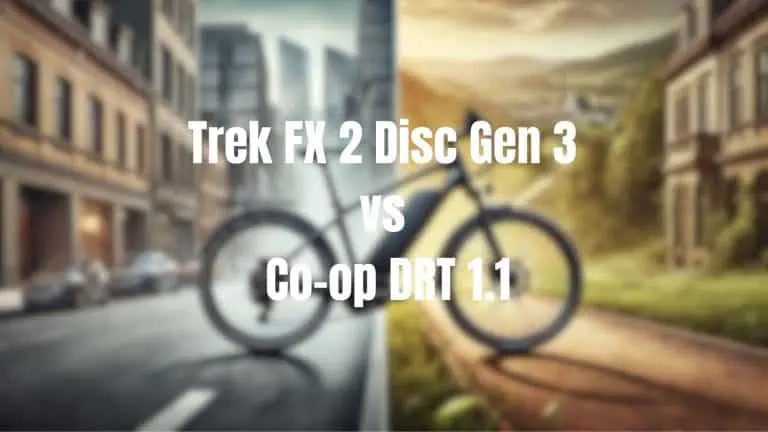Co-op CTY 2.1 vs Priority Brilliant L-Train

Co-op CTY 2.1 and the Priority Brilliant L-Train are both bikes designed for urban riding, but they approach this task with different design philosophies. This detailed comparison will help you understand the unique characteristics of each model and determine which might better suit your urban cycling needs.
Comparison Table
| Feature | Co-op CTY 2.1 | Priority Brilliant L-Train |
|---|---|---|
| Price | $799.00 | $750.00 |
| Bike Type | Hybrid Bike | Hybrid Bike (Commuter) |
| Frame Material | 6061 aluminum | Chromoly steel |
| Wheel Size | 700c | 700c |
| Suspension | No Suspension | No Suspension |
| Drivetrain | Shimano | Shimano |
| Gearing | 16 gears | 7 gears |
| Brakes | Hydraulic Disc | V-Brakes |
| Weight | 30 lbs. | 30 lbs. |
Price and Value
- Co-op CTY 2.1: $799.00
- Priority Brilliant L-Train: $750.00
The Co-op CTY 2.1 is $49 more expensive than the Priority Brilliant L-Train. This relatively small price difference suggests that both bikes are competing in a similar market segment, with the slight premium for the CTY 2.1 possibly reflecting its disc brakes and wider gear range.
Bike Type and Frame Material
Both bikes are classified as hybrid bikes, designed for urban use, but they have different approaches:
- Co-op CTY 2.1: Hybrid Bike, 6061 aluminum
The CTY 2.1 uses 6061 aluminum, which is common for hybrid bikes. It offers a good balance of light weight, stiffness, and durability. - Priority Brilliant L-Train: Hybrid Bike (Commuter), Chromoly steel
The L-Train uses a chromoly steel frame, known for its durability, comfort, and ability to absorb road vibrations. It’s designed specifically as a commuter bike, with geometry optimized for urban riding.
The choice of frame material significantly impacts the ride quality. The CTY 2.1’s aluminum frame will likely feel more responsive and lighter, while the L-Train’s steel frame may offer a smoother, more comfortable ride, especially over rough urban surfaces.
Wheel Size
Both bikes feature 700c wheels, which are standard for road and hybrid bikes. This wheel size provides good rolling efficiency and speed on paved surfaces. The consistency in wheel size means that both bikes will have similar characteristics in terms of rolling resistance and the ability to maintain speed.
Suspension
Neither bike features suspension, which is typical for urban-focused bikes. The lack of suspension helps keep the weight down and improves pedaling efficiency on paved surfaces. This design choice indicates that both bikes are primarily intended for use on roads and smooth paths rather than rough terrain.
Drivetrain and Gearing
- Co-op CTY 2.1: Shimano, 16 gears
The CTY 2.1 uses a traditional chain drive with a Shimano drivetrain offering 16 gears. This provides a good range of gearing options for various urban riding conditions, including hills. - Priority Brilliant L-Train: Shimano, 7 gears
The L-Train features a belt drive system with a Shimano Nexus 7-speed internal gear hub. This system offers several advantages for urban riding: - Lower maintenance (no need to lubricate)
- Cleaner operation (no grease to get on clothes)
- Quieter ride
- Longer lifespan than traditional chains
While the L-Train offers fewer gears, the internal gear hub provides smooth shifting and is well-suited for urban riding conditions.
Brakes
- Co-op CTY 2.1: Hydraulic Disc
- Priority Brilliant L-Train: V-Brakes
This is a significant difference between the two bikes. The CTY 2.1’s hydraulic disc brakes offer superior stopping power and better performance in all weather conditions. They typically require less finger effort to engage and provide better modulation.
The L-Train’s V-Brakes are simpler, lighter, and adequate for most urban riding conditions. However, they may not perform as well as disc brakes in wet conditions or on steep descents.
Weight
Both bikes weigh 30 lbs., which is reasonable for urban hybrid bikes. The similar weight suggests that the CTY 2.1’s lighter aluminum frame is offset by its disc brakes and more complex drivetrain, while the L-Train’s heavier steel frame is balanced by its simpler braking system and drivetrain.
Read more: Co-op DRT 1.1 vs Priority Brilliant L-Train
Riding Position and Comfort
Both bikes likely offer a relatively upright riding position, typical of urban-focused bikes:
- This position provides good visibility in traffic and comfort for shorter rides.
- The L-Train, being more commuter-focused, may offer a slightly more upright position for enhanced comfort and visibility in urban traffic.
The L-Train’s steel frame may provide a smoother ride by absorbing more road vibration, which could be beneficial for comfort on longer commutes.
Which is Better?
The choice between the Co-op CTY 2.1 and the Priority Brilliant L-Train depends on your specific needs and preferences:
- Maintenance: If you prioritize low maintenance, the L-Train’s belt drive and internal gear hub system is a significant advantage.
- Versatility: The CTY 2.1, with its wider range of gears, offers more versatility for varied terrain, including steeper hills.
- Braking Performance: The CTY 2.1 has a clear advantage with its hydraulic disc brakes, especially in wet conditions or for riders who prioritize maximum stopping power.
- Ride Quality: The L-Train’s steel frame may offer a smoother ride, which could be preferable for riders prioritizing comfort, especially on longer commutes.
- Gearing: If you frequently ride in hilly areas, the CTY 2.1’s 16 gears offer more options for tackling varied terrain.
- Cleanliness: The L-Train’s belt drive system is cleaner to operate, which can be a significant advantage for commuters who ride in work clothes.
In conclusion, the Co-op CTY 2.1 is the better choice for riders seeking a more versatile bike that can handle a variety of urban conditions, including steep hills. Its hydraulic disc brakes and wider gear range make it suitable for riders who prioritize performance and adaptability.
The Priority Brilliant L-Train is ideal for dedicated urban commuters who prioritize low maintenance, cleanliness, and comfort on relatively flat terrain. Its belt drive system and internal gear hub make it a reliable, clean, and quiet option for daily riding in the city.
Consider your primary riding purpose, the terrain of your typical routes, your maintenance preferences, and how much you value performance versus comfort when making your decision. Both bikes offer quality rides but cater to somewhat different needs within the urban cycling category.





